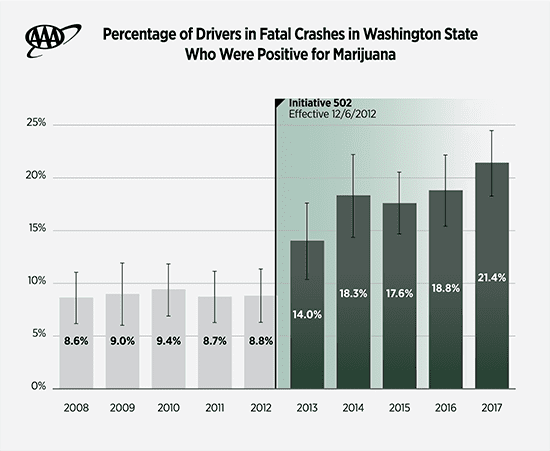Percentage of THC-positive drivers in fatal wrecks doubled after Washington State legalized recreational use
BOISE – (January 30, 2020) – New research by the AAA Foundation for Traffic Safety indicates that five years after Washington State legalized the recreational use of marijuana, the number of THC-positive drivers involved in fatal crashes is alarmingly high – more than double the percentage of drivers before legalization. THC is the main psychoactive component in cannabis, and the detection of THC is suggestive of recent or frequent use.
AAA compared the five years before Washington Initiative 502 was enacted with the five years since recreational use has been permitted. Before the law took effect, an average of nine percent of all drivers in fatal crashes statewide tested positive for marijuana. In the years since, that number has ballooned to 18 percent.

In 2017 (the most recent year of available data), the problem grew. An estimated 21 percent of all drivers involved in fatal crashes in Washington State were THC-positive, higher than any other year in the ten-year study period.
THC levels spike in the bloodstream shortly after cannabis is smoked, and they decline substantially by the time of peak impairment, which generally occurs about 90 minutes after consumption.
“Marijuana can have an impairing effect on drivers, reducing their attentiveness and ability to react to the environment around them, including driving defensively. It can also cause drivers to wander more in their lanes,” says AAA Idaho Public Affairs Director Matthew Conde. “Research shows that driving after using marijuana may as much as double a driver’s odds of causing a crash.”
In a separate study by the Highway Loss Data Institute, the legalization of recreational marijuana in Washington, Colorado and Oregon was associated with an increase in the number of automobile collision claims when compared with states that have not legalized it (a 10 percent increase in Washington, and a 13 percent increase in Colorado).
AAA opposes measures to legalize the recreational use of marijuana because of the negative traffic safety implications, including putting the public’s safety at risk. Most states aren’t ready to tackle the potentially high number of marijuana-impaired driving issues that come with legalization, including having enough trained law enforcement personnel, adequate roadside detection, a robust court and legal system, and an effective process to collect and analyze the resulting data.
AAA also opposes the establishment of arbitrary per se standards (convicting someone of a DUI solely based on a given number of nanograms of THC per milliliter in their blood), because no testing procedures exist to reliably determine impairment based on the amount of THC alone.
Unlike the more-predictable effects of alcohol, an inexperienced marijuana user may be impaired by eating or smoking a relatively small amount, while a person with a longer history of using cannabis may not be. AAA recommends that impaired driving laws include the observation of dangerous behaviors and test for the presence of THC.
“It’s a bit of a double-edged sword, because users really aren’t sure how much marijuana they can consume before they become impaired,” Conde explained. “That should give us all reason to pump the brakes on legalizing a substance that we don’t completely understand.”
AAA urges all states to adopt comprehensive enforcement measures to improve road safety and detect marijuana-impaired drivers, including increasing the number of Drug Recognition Experts and Advanced Roadside Impaired Driving Enforcement (ARIDE)-trained officers. Whenever there is a fatal crash, all drivers (living and dead) should be tested for the presence of alcohol and other drugs, and that information should be used to keep a close eye on impaired driving trends.

